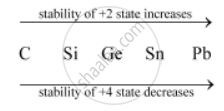Advertisements
Advertisements
Question
Discuss the pattern of variation in the oxidation states of C to Pb.
Solution 1
The electronic configuration of group 14 elements is ns2 np2. Therefore, the most common oxidation state exhibited by them should be +4. However, the +2 oxidation state becomes more and more common on moving down the group. C and Si mostly show the +4 state. On moving down the group, the higher oxidation state becomes less stable. This is because of the inert pair effect. Thus, although Ge, Sn, and Pb show both the +2 and + 4 states, the stability of the lower oxidation state increases and that of the higher oxidation state decreases on moving down the group.
| Group 14 element | Oxidation state |
| C | +4 |
| Si | +4 |
| Ge, Sn, Pb | +2, +4 |

Solution 2
The common oxidation states are +4 and +2. Stability of +4 oxidation state decreases from C to Pb. Details can be seen from the text part.
APPEARS IN
RELATED QUESTIONS
Discuss the pattern of variation in the oxidation states of B to Tl.
Explain why is there a phenomenal decrease in ionisation enthalpy from carbon to silicon?
Write suitable chemical equations to show the nature of the following oxide.
Tl2O3
Rationalise the given statement and give a chemical reaction:
Lead (IV) chloride is highly unstable towards heat.
Classify the following oxide as neutral, acidic, basic or amphoteric:
CO
Classify the following oxide as neutral, acidic, basic or amphoteric:
B2O3
Classify the following oxide as neutral, acidic, basic or amphoteric:
SiO2
Classify the following oxide as neutral, acidic, basic or amphoteric:
PbO2
Write suitable chemical equations to show the nature of the following oxide.
SiO2
Write suitable chemical equations to show the nature of the following oxide.
Al2O3
Write suitable chemical equations to show the nature of the following oxide.
PbO2
The reason for small radius of Ga compared to Al is:
(i) poor screening effect of d and f orbitals.
(ii) increase in nuclear charge.
(iii) presence of higher orbitals.
(iv) higher atomic number.
The linear shape of CO2 is due to:
(i) sp3 hybridisation of carbon.
(ii) sp hybridisation of carbon.
(iii) pπ – pπ bonding between carbon and oxygen.
(iv) sp2 hybridisation of carbon.
Explain the following:
CO2 is a gas whereas SiO2 is a solid.
Explain the following:
Carbon shows catenation property but lead does not.
Explain the following:
Why does the element silicon, not form a graphite like structure whereas carbon does.
A tetravalent element forms monoxide and dioxide with oxygen. When air is passed over heated element (1273 K), producer gas is obtained. Monoxide of the element is a powerful reducing agent and reduces ferric oxide to iron. Identify the element and write formulas of its monoxide and dioxide. Write chemical equations for the formation of producer gas and reduction of ferric oxide with the monoxide.
\[\ce{SiCl4 ->[H2O] (A) ->[\Delta] (B) ->[Na2CO3][heat] (C)}\]. The Compound C is ______.
Which one of the following compounds of Group–14 elements is not known?
